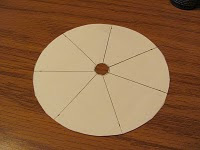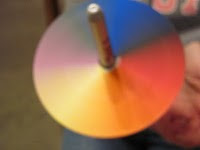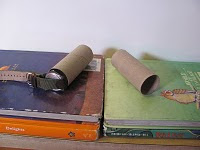Monday, March 29, 2010
Experiment 1- Is Water Hard?
by: Tonya Estep and Jessica Vaughn
Hard water is water that contains many dissolved minerals. If water is considered "hard," soap will not easily form bubbles. Distilled water is not "hard" water. We tested two types of water, distilled and tap(well), to determine if it was hard or not.


2. Pour distilled water into one screw-top jar and the same amount of tap water into the other. Put a drop of liquid soap solution into the jar of tap water and screw on the lid.

3. Shake the jar. If it does not foam, repeat step 2 and shake it again. Count the number of drops it takes to make the foam.

4. Repeat steps 2 and 3 with the distilled water.

Yes, the tap water took twice as many drops as the distilled water to make the same amount of foam, therefore the tap water was "hard".
So, how can you change the hardness of water? If the water is too hard, it is because of relatively high amounts of dissolved minerals like calcium and carbonates. To soften the water, use a filter that will strip the dissolved chemicals away. If the water is too soft, try adding a chemical buffer to it until it reaches the pH you want. Baking soda, or sodium bicarbonate, is a cheap chemical buffer. Limestone is another way to keep the water from becoming too soft.
GLE 0607.T/E.1 Use appropriate tools to test for strength, hardness, and flexibility of materials.
Sunday, March 28, 2010
Experiment 2- Spin Some Colors
Spin Some Colors
By: Jessica Vaughn and Tonya Estep

Materials needed: Paint (violet, indigo, blue, green, yellow, orange and red), paintbrushes, sharp pencil, scissors, protractor, water for paint, white card stock
Step 1: Cut out a circle from the card stock. Use the protractor to mark seven sections. Make a hole in the center of the disk.

Step 2: Paint each of the seven sections a different color. Allow to dry.

Step 3: Place a pencil/Sharpie through the hole and spin the disk.



Why do the colors appear white?
When the plate is spinning, your eyes cannot separate each color and
identify it. In the whirl, all your eyes can see is white! Light
plays a big factor in how we view objects, especially color. When you
look at a moving object, the color you see distorts itself because of
how your brain registers what it is seeing. This science experiment
is just like a magic trick: now you see it, now you don’t!
For this experiment, we had to use black instead of indigo. The
experiment might have worked better if we had used the correct color.
Standards
GLE 0407.Inq.2 Select and use appropriate tools and simple equipment to conduct an investigation.
GLE 0407.Inq.3 Organize data into appropriate tables, graphs, drawings, or diagrams.
GLE 0407.10.2 Investigate how light travels and is influenced by different types of materials and surfaces.
Related Science Project Links
Tuesday, March 9, 2010
Experiment 3- Bounce a Sound




Sound waves travel down the tube. When a plate is placed at the end of the tubes, the sound bounces off of the hard plate and travels up the second tube to your ears. However, when you place the soft cork in the same location, it soaks up the sound waves, making it harder to hear the ticking watch.
Standards
GLE 0307.11.2 Use a variety of materials to produce sounds of different pitch and volume.
GLE 0307.Inq.2 Select and use appropriate tools and simple equipment to conduct an investigation.
Related Science Project Links
Andrea Dalton's Project- See Some Sound
LaToya Keaton's Project- How the Ear Works
Below is the mini lesson and worksheet for this lesson
Monday, March 8, 2010
Real Life Science Project
Questions to think about: Why does lemon juice keep apples from turning brown? Would a different type of juice work better?
Topic- Fresh Apples
Purposes of the study- What is the best way to keep apples from turning brown?
Research questions/ hypotheses- My hypotheses is that I think lemon juice is the best way to keep apples from turning brown.


Materials: apple, lemon juice, lime juice, cranberry juice, sharp knife, and clock
Process:
1. Cut the apple in half from top to bottom.
2. On one apple half, lightly coat the white part of the apple with lemon juice. Leave the other half uncoated. (The uncoated half is your "control" sample and let's you see what normally happens to a cut open apple.)




3. Observe the color of both apple halves, then place them white-part-up on a counter or tabletop.
4. Observe the apples again after 30 minutes. Notice any color changes and/or differences in appearance.
5. Look at the apples again periodically throughout the day. What do you find?
Results and Findings

After doing this experiment, I discovered that the lime and lemon juice both produced the same results. Also, the cranberry juice produced the same results as the control apple with no juice applied.
Things to consider during the experiment:
- Amount of juice applied to each apple
- Whether the fruit is fresh or not
- Cutting the apple into halves takes longer to see results than cutting the apple into fourths
When an apple is cut open, an enzyme called polyphenol oxidase is released from the cells of the apple and reacts with the oxygen in the air. This reaction causes the fruit to turn brown, similar to rust forming on metal. Almost all plants contain polyphenol oxidase, and it is believed plants use this enzyme as part of a defense mechanism. When a plant is damaged, the browning of the affected area is thought to discourage animals and insects from eating the plant any further. It also might help the plant heal because the browning creates an antibacterial effect, preventing germs from destroying the plant even more.
Lemon juice helps keep the apple from browning, because it is full of ascorbic acid (Vitamin C) and it has a low (acidic) pH level. Ascorbic acid works because oxygen will react with it before it will react with the polyphenol oxidase. However, once the ascorbic acid gets used up, the oxygen will start reacting with the enzyme and browning will occur. Lemon juice's low pH level also helps prevent browning. Polyphenol oxidase works best when the pH level is between 5.0 and 7.0. However, below a pH level of 3.0, the enzyme becomes inactivated. The pH of lemon juice is in the 2.0 range, making it very effective against browning. Lime juice and cranberry juice also have a pH below 3.0.
Click below for references and extended resources or acknowledgment:
http://www.hometrainingtools.com/article.asp?ai=1461&bhcd2=1270475863
http://www.indiacurry.com/chutney/foodphlevel.htm

